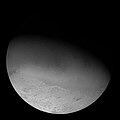Set Catena
Set Catena consists of semi-regularly spaced pits roughly 20 km (12 mi) separated from each other, with each pit being on average 10 km (6.2 mi) and up to 500 m (1,600 ft) deep. The pits may have formed from collapse or from explosive cryovolcanic eruptions, and may have been subsequently expanded by mass wasting processes. Set Catena may be a northeastern extension of Raz Fossae, a similar fault system southwest of Leviathan Patera.
As with all other surface features of Triton, Set Catena was discovered when Voyager 2 visited the Neptune system on 25 August 1989. It is named after the deity Set from Egyptian mythology, with the name being officially approved by the International Astronomical Union (IAU) in 1991. It is located at approximately 22°N, 33°30E, within Cipango Planum and Monad Regio.
See also
References
- ^ "Set Catena". Gazetteer of Planetary Nomenclature. USGS Astrogeology Research Program. (Center Latitude: 22.00°, Center Longitude: 33.50°; Planetographic, +East)
- ^ Schenk, Paul; Beddingfield, Chloe; Bertrand, Tanguy; et al. (September 2021). "Triton: Topography and Geology of a Probable Ocean World with Comparison to Pluto and Charon". Remote Sensing. 13 (17): 3476. Bibcode:2021RemS...13.3476S. doi:10.3390/rs13173476.
- ^ Stern, A. S.; McKinnon, W. B. (March 1999). Triton's Surface Age and Impactor Population Revisited (Evidence for an Internal Ocean) (PDF). 30th Annual Lunar and Planetary Science Conference. Houston, TX. Bibcode:1999LPI....30.1766S. 1766. Archived (PDF) from the original on 2 April 2024. Retrieved 2 April 2024.
- ^ "Triton:Part of the Ocean World Club?" (PDF). Archived (PDF) from the original on 31 October 2022.
- ^ Martin-Herrero, Alvaro; Romeo, Ignacio; Ruiz, Javier (2018). "Heat flow in Triton: Implications for heat sources powering recent geologic activity". Planetary and Space Science. 160: 19–25. Bibcode:2018P&SS..160...19M. doi:10.1016/j.pss.2018.03.010. S2CID 125508759.
